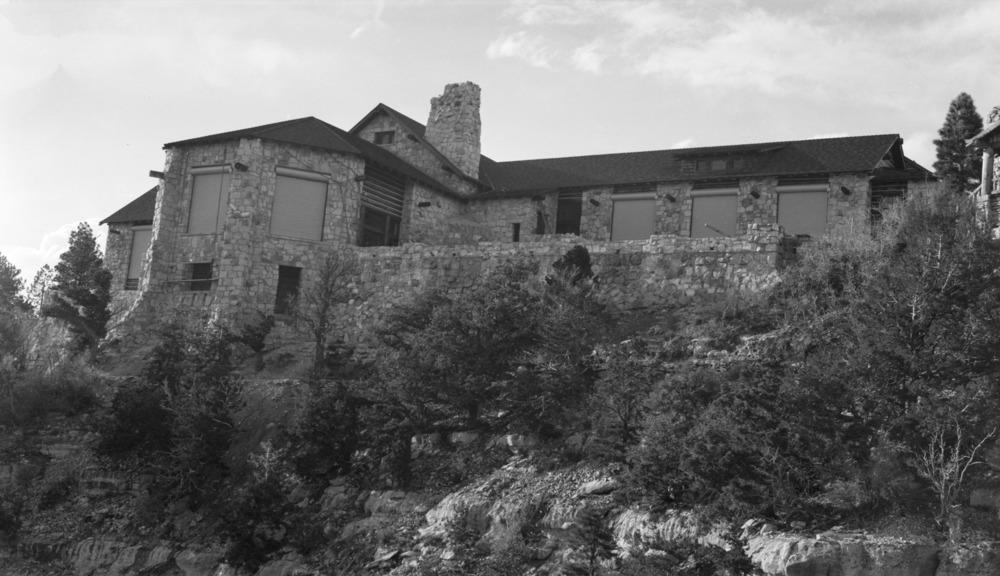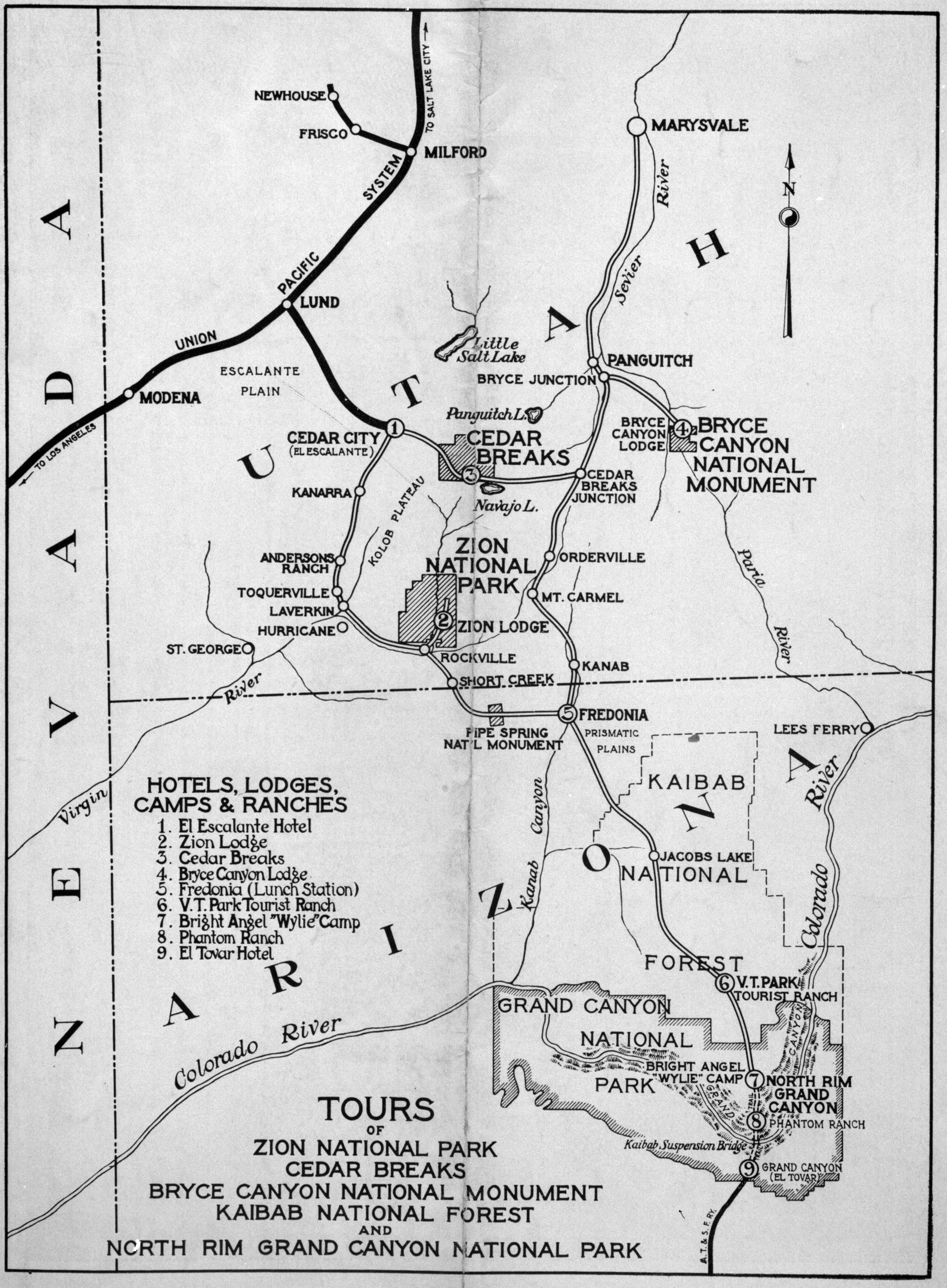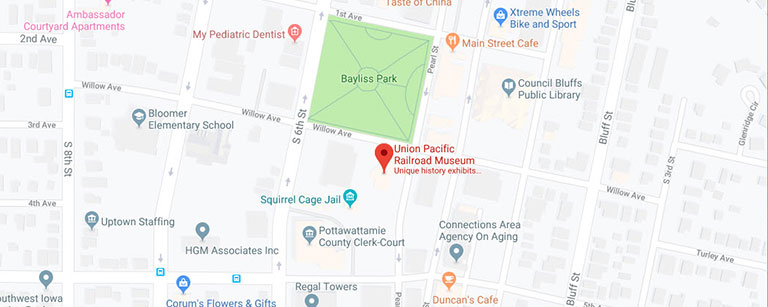Iconic Lodge on the North Rim of the Grand Canyon is Again Destroyed by Fire

Figure 1: Original memo from Utah Parks Co. office in Cedar City, Utah, notifying Union Pacific of the lodge fire on September 1st, 1932. Union Pacific Collection.
On July 12, 2025, the Dragon Bravo Fire expanded suddenly destroying the facilities at the North rim of the Grand Canyon, including the historic lodge. This fire was started by lightning and destroyed the lodge and surrounding buildings. The current lodge was itself rebuilt after a fire starting in the early hours of the morning on September 1, 1932. Reports from the files in the Union Pacific Collection report that the fire began in the ladies’ toilet just before 4 a.m.
Why does the Union Pacific Collection have records on the Lodge at the North Rim of the Grand Canyon? It’s a great story of partnership and celebration of the Nation’s precious natural wonders in which Union Pacific was perhaps a surprising early partner.

Figure 2: First lodge, designed by G.L. Underwood, 1938, North Rim of the Grand Canyon, PHYS_3630, Union Pacific Collection.
After the National Park Service was founded in 1916, the fledgling agency needed help. The traditional police force of the national parks, the United States Army, had vacated their presence in 1918. The park rangers now had to work full time just to keep out squatters, poachers and cattle ranchers. They had almost no resources to cater to visitors or even to park development. This was largely left to railroad partners, instrumental in the establishment of the agency and who built roads, cabins, hotels and provided concessions at most western National Parks. Union Pacific provided access to national parks otherwise virtually impossible to visit easily like Zion, the North Rim of Grand Canyon and Death Valley National Monument

Figure 3: Union Pacific advertisement, c1929, PHYS_1785, Union Pacific Collection
To provide these services, Union Pacific needed unique designs for what would become the iconic lodges, and they turned to consulting architect, Gilbert Stanley Underwood. Underwood had been employed by Union Pacific to design several depots, and stations throughout their western system, but from 1924 through 1928, Underwood also designed lodges, dining halls and cabins for Union Pacific, culminating in a spectacular lodge on the Grand Canyon’s north rim. The architect, always conscious of a sense of place, began utilizing a traditional “rustic” style to a stylized interpretation combining native stone and wood with expansive windows allowing visitors to enjoy breathtaking views. The original Grand Canyon Lodge’s design became iconic for Underwood’s “Parkitecture” design and later became universally recognized as the standard for National Park lodges throughout the West.

Figure 4: Construction in progress on main lodge, c1927, PHYS_3502, Union Pacific Collection
Construction, however, was difficult, and a tramway was needed to transport the enormous logs to the construction site on the canyon’s remote north rim. The poles passed through several tension towers on their way to their destination. The completed lodge, opened in 1928, was placed strategically on the canyon’s edge to offer guests the best views, and included deluxe cabins and a dining area. The stunning views and amenities astounded visitors and were heavily photographed by the railroad’s own PR department, creating a documentary record of park amenities stretching almost 50 years! [https://www.up.com/about-us/history/photos]
Unfortunately, the reliance on wood in remote areas led to the eventual loss of all the iconic park lodges from fire. The Grand Canyon Lodge stood for only four years before it burned to the ground and was rebuilt in a somewhat less majestic style incorporating more stone and concrete but nonetheless stood the test of time until this past weekend when a tragic wildfire ended the legacy.

Figure 5: Tramway to transport logs for construction of the original lodge on the North Rim of the Grand Canyon, c1927, PHYS_3148, Union Pacific Collection.
For nearly fifty years, visitors to southern Utah could arrive at the train station in Cedar City and board a Utah Parks Company touring car or bus for a 489-mile fully escorted tour of Utah’s natural treasures. Most visitors spent at least one night at each park and then were sent on to the next park with a “sing-away” by the full staff.

Figure 6: The rebuilt Grand Canyon Lodge at the North Rim of the Grand Canyon, c1934, PHYS_4496, Union Pacific Collection.

Figure 7: Map showing the Utah Parks Co. "Circle Tour," PHYS_2868, Union Pacific Collection
As with other railroad destinations, the Utah Parks Company was not expected to make money, it was created to bring passengers to the railroad. Union Pacific took a broad view of the costs to run the lodges and tour operation and determined that increased passenger traffic and free publicity offset losses at the lodges. That position held if most visitors arrived by train, but by the 1950s 75 percent of visitors were arriving by car. Union Pacific calculated that between 1923 and 1957, Utah Parks Company lost $3.5 million dollars. With no passenger revenue to offset the losses, the railroad began looking for a buyer for the Utah Parks Company. Because the venture was a partnership with the National Park Service, sale of the facilities and tour operations had to be approved by NPS. After several failed attempts to reach a sale that was acceptable to all parties, in 1972 the railroad donated all its facilities at Zion, Bryce, Cedar Breaks and the Grand Canyon to the National Park Service.

